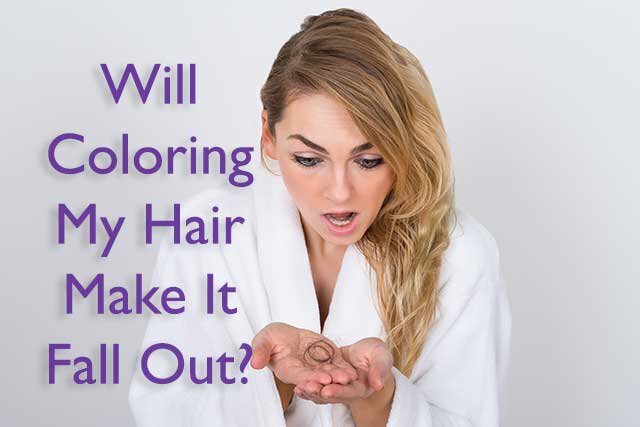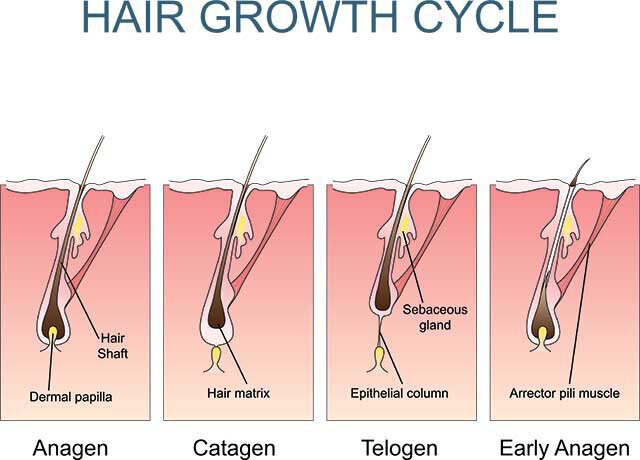


Why they may be there:
After you’ve dyed or highlighted your hair, you may notice more hair “loss”. Why?
Hair dyeing weakens the hair. Permanent and semi permanent hair coloring products contain peroxide and ammonia. The ammonia swells and opens the hair cuticle to allow the dyes and peroxide to get inside and cause a color change. These openings are partially closed when a color-stop shampoo step or ph-balancing condition is used. This change in the hair integrity makes colored hair more porous and also weaker, so breakage of dyed hair is usually much more evident.
(Non ammonia hair colors that claim no ammonia use an ammonia-like ingredient that does the same thing, but without the odor. Don’t be fooled into thinking the “no ammonia” claim is less damaging to hair.)
Hair that is bleached or lightened takes the heaviest hit. For the most part, hair loss for those of you who routinely color your hair with permanent hair color is generally from breakage, not actual permanent loss. (But it is possible if you make repeated drastic bleaching attacks where you place bleach on the scalp and not just on the hair.)
Yes, stress can cause hair loss. Your entire system is regulated by hormones and stress can seriously alter the normal interaction of hormones. For a more indepth explanation, see this Mayo Clinic article.
Medical conditions and some medications can cause hair loss.
If you experience consistent or unusual hair loss (as opposed to breakage) see your doctor. And if you are taking medications, check for that side effect. Sometimes you can switch to a similarly acting drug that doesn’t cause you to lose hair.
You can’t fight genetics. Some people will suffer hair loss not matter what.
Since hair breakage is often a big factor, it’s good to discern if the hair you see in the sink or in your brush is “lost hair” or broken hair. “Lost” hairs will have a bulb attached at the end growth end. Broken hairs do not. If breakage is your problem. treat your hair gently. That means not tugging or using hard plastic or metal brushes, warm vs hot water for shampooing, turning down the heat on the hair dryer or simply air drying, using gentle shampoos and making sure you aren’t using hair coloring products that are too strong for your hair. (Some drug store hair colorings are only for dark hair, so pay attention to labeling.)
Rogaine works and you can buy it over the counter. It may not a cure all for a real medical condition and it won’t change stress levels or bad hair habits, but it will promote hair growth when there are viable hair follicles. (Once the follicle is dead, no hair will grow there again.) A negative with Rogaine is the necessary daily application, which most women resist since it can “undo” the hair-do.
Some possible product / treatment recommendations
Kaval Shampoos are useful in treating clogged scalps and strengthening weak hair. Real hair thinning requires more. Read about PRP for thinning hair.
Your hair grows in cycles, so you will sometimes notice more hair in your brush or on the shower drain or sink. Old hairs fall out while new ones grow in. If it’s a persistent abundance of hair loss and you notice your hair actually feeling thinner, there may be other things going on.
SHEDDING HAPPENS
A little hair in the shower drain or your hairbrush is nothing to be concerned about. Most of us shen an average of 50–100 strands per day, which will be replaced in the natural cycle.

Every hair on your head is constantly going through one of the 3 stages of the hair growth cycle. The growth phase, called anagen, can last up to 6 years.
Once the hair stops growing, it enters into catagen, or the transition phase which lasts about 2 to 3 weeks.
During this phase, the hair rests for 2 or 3 months before it’s shed by the follicle.
After the hair has been shed, a new hair begins to grow, and the cycle repeats itself. However, if a hair follicle dies, no new hair will be created
"WOW! I went into my appointment with a negitive attitude. I have all of my cosmetic procedures done in Europe and have very high standards. Even though I came across skeptical, I was treated with patience and respect. I had PRP and Botox and am so impressed with the quality and results. It is so nice to have a doctor that knows what he’s doing!
Thank you!!!!!"
Schedule your consultation with board-certified dermatologist Dr. Nissan Pilest at Total Dermatology in Irvine, CA today by calling (949) 727-3800.
When it comes to your skin and your health, it really is all about what’s best for you. Total Dermatology understands this, which is why we offer versatile treatments with experienced and highly trained aesthetic professionals led by Dr. Nissan Pilest. Your Total Dermatology transformation awaits.